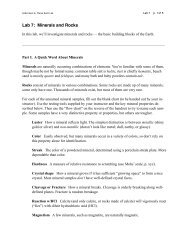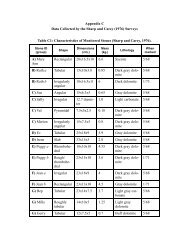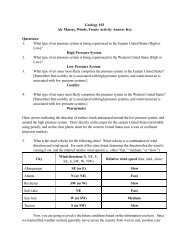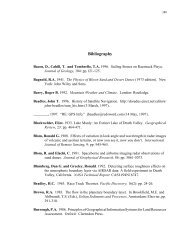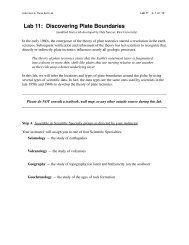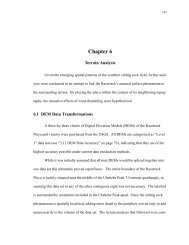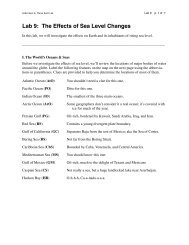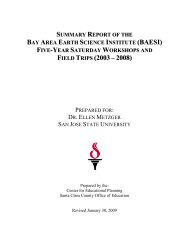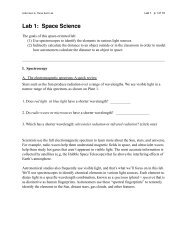Geologic framework and history of the Santa Teresa Hills
Geologic framework and history of the Santa Teresa Hills
Geologic framework and history of the Santa Teresa Hills
You also want an ePaper? Increase the reach of your titles
YUMPU automatically turns print PDFs into web optimized ePapers that Google loves.
<strong>Geologic</strong> <strong>framework</strong><br />
<strong>and</strong> <strong>history</strong> <strong>of</strong> <strong>the</strong><br />
<strong>Santa</strong> <strong>Teresa</strong> <strong>Hills</strong><br />
Richard Sedlock, SJSU Geology
Major Points<br />
• Rocks in <strong>the</strong> <strong>Santa</strong> <strong>Teresa</strong> <strong>Hills</strong> record major<br />
events in California’s geologic <strong>history</strong>.<br />
• Serpentinite (<strong>the</strong> “rocky unit”) <strong>and</strong> mélange<br />
(<strong>the</strong> “grassy unit”) formed in a subduction<br />
zone in <strong>the</strong> Jurassic <strong>and</strong> Cretaceous.<br />
• They are in contact at a fault that (1) is no<br />
longer active, <strong>and</strong> (2) has a SHALLOW<br />
inclination, contrary to most published maps.
Major Points, cont.<br />
• Tertiary sedimentary rocks sit on top <strong>of</strong> <strong>the</strong><br />
older serpentinite <strong>and</strong> mélange.<br />
• The plate boundary in California changed<br />
from a subduction zone to a transform fault<br />
about 15 million years ago.<br />
• The <strong>Santa</strong> <strong>Teresa</strong> <strong>Hills</strong> were raised in <strong>the</strong> last<br />
several million years, due partly to <strong>the</strong><br />
dem<strong>and</strong>s <strong>of</strong> a bend in <strong>the</strong> San Andreas fault.
Earth’s tectonic plates
Types <strong>of</strong> plate boundaries
A typical subduction zone
<strong>Geologic</strong><br />
map <strong>of</strong><br />
California
Old California:<br />
The subduction zone<br />
• The cross section is a “Frankenstein” image<br />
that shows seismic reflection data collected<br />
at many places around <strong>the</strong> modern world.<br />
• U.S. <strong>Geologic</strong>al Survey personnel spliced<br />
<strong>the</strong>m toge<strong>the</strong>r to illustrate a probable eastwest<br />
cross section <strong>of</strong> California in <strong>the</strong> mid-<br />
Cretaceous (about 100 million years ago).
Subduction-zone rock units<br />
in <strong>the</strong> <strong>Santa</strong> <strong>Teresa</strong> <strong>Hills</strong><br />
• Serpentinite is metamorphosed mantle. It is<br />
<strong>the</strong> “rocky unit.”<br />
• Mélange is a mixture <strong>of</strong> isolated blocks in a<br />
matrix <strong>of</strong> sheared s<strong>and</strong>stone <strong>and</strong> shale. It is<br />
<strong>the</strong> “grassy unit.”
<strong>Geologic</strong> map <strong>of</strong> part <strong>of</strong> <strong>the</strong> <strong>Santa</strong> <strong>Teresa</strong> <strong>Hills</strong>
<strong>Geologic</strong> map <strong>of</strong> part <strong>of</strong> <strong>the</strong> <strong>Santa</strong> <strong>Teresa</strong> <strong>Hills</strong>
<strong>Geologic</strong> map <strong>of</strong> part <strong>of</strong> <strong>the</strong> <strong>Santa</strong> <strong>Teresa</strong> <strong>Hills</strong>
Cross-section <strong>of</strong> <strong>the</strong> <strong>Santa</strong> <strong>Teresa</strong> <strong>Hills</strong><br />
(USGS) (SW-NE, through Stile Ranch)
Cross-section <strong>of</strong> <strong>the</strong> <strong>Santa</strong> <strong>Teresa</strong> <strong>Hills</strong><br />
(Sedlock/SJSU) (SW-NE, through Stile Ranch)<br />
serpentinite<br />
Tertiary<br />
sedimentary rocks<br />
serpentinite<br />
Franciscan mélange with exotic blocks
Q: Whence <strong>the</strong> serpentinite<br />
Q: How were serpentinite & mélange juxtaposed
Mt. Hamilton<br />
Calaveras fault<br />
Calaveras fault<br />
serpentinite
Movie won’t play in<br />
PDF format; obtain<br />
separate QuickTime file
Modern<br />
tectonic<br />
setting
<strong>Santa</strong> <strong>Teresa</strong> <strong>Hills</strong><br />
Satellite image <strong>of</strong> <strong>the</strong> Bay Area<br />
Active faults shown in red
Note <strong>the</strong> bend in <strong>the</strong> San Andreas fault
Conclusions<br />
• The hills <strong>of</strong> <strong>the</strong> south Bay probably were raised<br />
in <strong>the</strong> last few million years.<br />
• The likely cause is <strong>the</strong> bend in <strong>the</strong> San Andreas<br />
fault, which causes thrust faulting, folding, <strong>and</strong><br />
crustal uplift.<br />
• The chief architect <strong>of</strong> <strong>the</strong> Bay Area, <strong>and</strong> <strong>the</strong> bane<br />
<strong>of</strong> its urbanized human population, is strike-slip<br />
faulting <strong>and</strong> its accompanying earthquakes.





